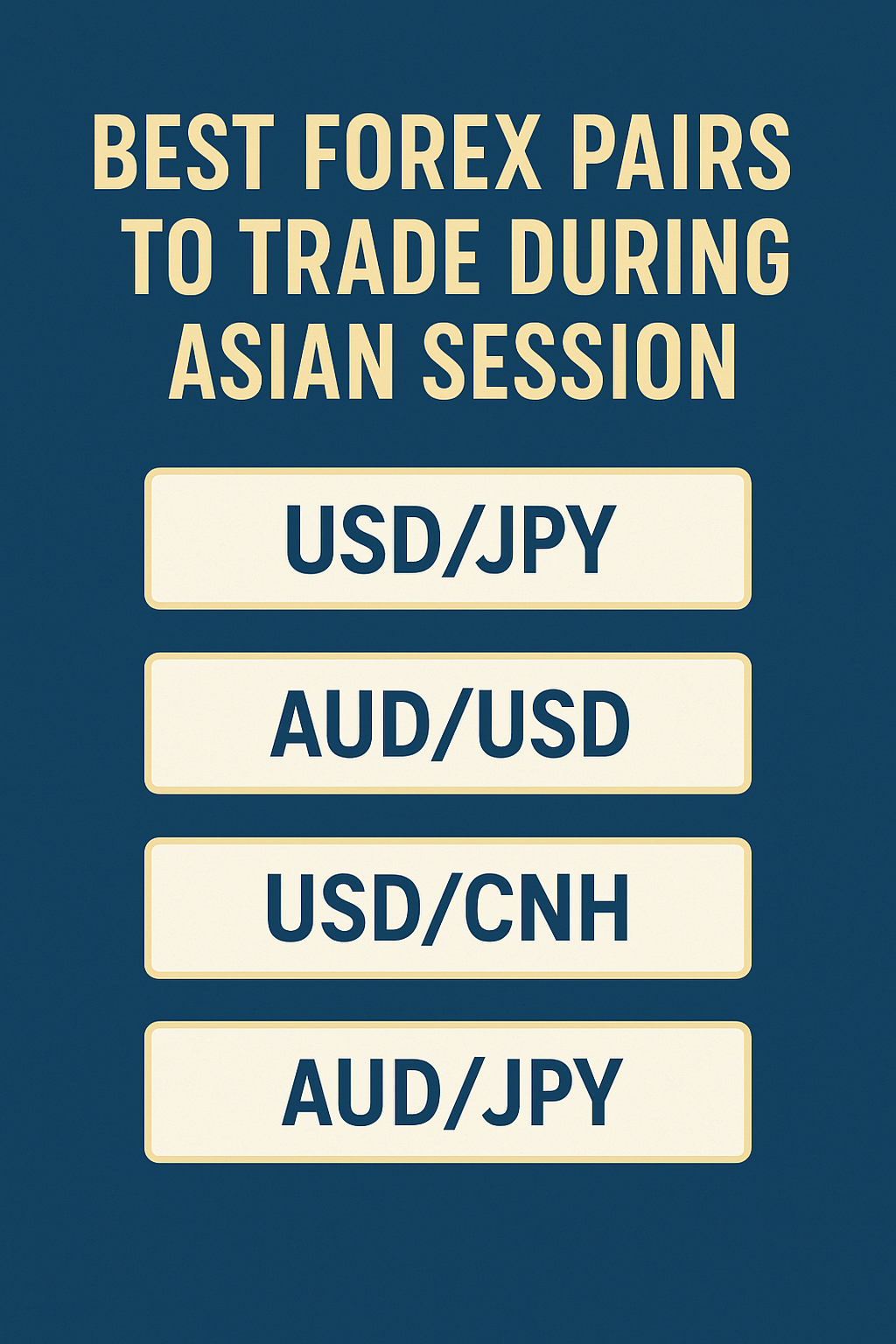In this article I will explore the Best Forex Pairs to Trade During Asian Sessions. These opportunities are most prevalent around the beginning of the Tokyo session where we can explore trading pairs with good liquidity and trending movements.
Knowing which forex pairs would be most beneficial to trade during this time will certainly help to trim down profits while also minimizing risks in the nascent hours of the market.
10 Best Forex Pairs to Trade During Asian Session”:
| Forex Pair | Key Point |
|---|---|
| USD/JPY | Most liquid pair in Asia with tight spreads and consistent movement. |
| AUD/USD | High volatility during Sydney and Tokyo overlap. |
| NZD/USD | Active due to New Zealand’s early session; suitable for news-based moves. |
| AUD/JPY | Volatile pair; responds well to risk sentiment and commodity trends. |
| NZD/JPY | Popular among carry traders; active during Asian hours. |
| EUR/JPY | Less volatile but good for swing trades during Tokyo session. |
| GBP/JPY | Higher volatility; ideal for experienced traders seeking sharp moves. |
| AUD/NZD | Regional pair with consistent moves driven by RBA/RBNZ news. |
| CHF/JPY | Slow but predictable; often used for low-risk positioning. |
| CAD/JPY | Influenced by oil prices; provides directional movement in Asia. |
Within the Asian trading session, specifically the Tokyo hours of 11:00 PM to 8:00 AM GMT, it is most optimal to trade forex pairs that include the Yen (JPY), Australian Dollar (AUD), as well as New Zealand Dollar (NZD) since these currencies are more liquid and have lower spreads because of the local market activity.
1. USD/JPY – Most liquid pair in Asia with tight spreads and consistent movement
USD/JPY trades the most, as Japan’s economy drives trade between the two nations. Its liquidity results in low cost bid-ask spreads which benefit scalpers and swing traders alike. The movement of the pair is smooth during the Tokyo session and greatly influenced by news emanating from the Bank of Japan or U.S. overnight data.
2. AUD/USD – High volatility during Sydney and Tokyo overlap
The volatility of AUD/USD spike with the Sydney and Tokyo overlap. Australia’s economic data is a moving factor such as employment numbers or interest rate announcements from the RBA. Moreover, the Australian dollar behaves like a commodity-linked currency and moves with the change of global risk sentiment which can be exploited in early Asian hours.
3. NZD/USD – Early New Zealand Sessions; ideal for news trading activities
This pair becomes active right at the start of the Asian trading session because of the earlier opening of New Zealand’s market. This pair is very sensitive to the economic events like the announcement of monetary policy change by RBNZ and the release of trade balance figures. With its relatively low spreads and good liquidity, this pair is suitable for traders using news-based strategies, especially those trying to capitalize on volatility during the later part of the Asian session.
4. AUD/JPY – Highly volatile; sensitive to risk appetite and commodity markets
This cross combination is one ofTubomost audaciously price volatile. It reacts aggressively to global risk sentiment and commodity market trends, particularly for Australia Rub and copper. The pair serves as a strong indicator of risk-on orExisting Edwards off market behavior. Both currencies rest heavily influenced by liseas of their countries-mostly policy実son in Decobie from coverage the ICLandomedoment Sipowing enderset to BoS in Lodererade.
5. NZD/JPY – Favored by carry traders; active in the Asian sessions
Carry traders prefer nz/jpy because New Zealand usually has higher interest rates than Japan. Movement from this pair is shaped by the RBNZ’s policies, exports, and overall market risk appetite. It generates steady action during Asian hours, which is advantageous for traders looking to capitalize on longer-term positions or yield-seeking strategies in a more tranquil atmosphere.
6. EUR/JPY – Somewhat lower volatility, but provides opportunities for Swing traders in the Tokyo session
EUR/JPY is less volatile than GBP/JPY or AUD/JPY, but provides consistent intraday movement. It also tends to mirror the Eurozone overnight sentiment and responds to technical levels. Swing traders are drawn to its clearer trends and calmer price action, particularly in the Tokyo session when the volume of market noise is lower.
7. GBP/JPY — Increased volatility; perfect for seasoned traders wanting quick shifts in market action.
GBP/JPY is one of the most volatile pairs during the Asian trading session owing to the unpredictable British pound and the heavily traded Japanese yen. This pair has sharp intraday movements which are very rewarding, but carries a lot of risk. It is ideal for advanced traders who are comfortable dealing with heightened volatility and need to be fast to react to news shocks.
8. AUD/NZD – Cross pair with persistent trends driven by monetary policy with RBA and RBNZ.
AUD/NZD is a regional cross pair with clean trends and persistent movements, shaped by diverging monetary policies of the RBA and RBNZ. Given the fact both nations share economic releases during Asian hours, this pair works well for those wanting to trade the relative strength of two closely intertwined economies. It is useful for traders focusing on fundamental-driven strategies.
9. CHF/JPY – Slow and methodical; often used for low-risk positioning
The CHF/JPY pair moves at a slower pace with lower volatility, making it easy to predict price action. Traders who want low-risk setups, or those who are hedging positions, commonly trade this pair. The Swiss Franc’s safe-haven status together with the yen’s stability during the Asian session makes the pair ideal for cautious traders or those who want very gradual directional changes.
10. CAD/JPY – Driven by oil; offers trade opportunities during Asian market hours
CAD/JPY illustrates the relationship between Japan’s economy and Canada’s commodity-based export economy. Because the Canadian dollar is pegged to the price of oil, movements within the energy markets during early Asian hours can cause moves in this pair. It is preferred by those trading macro themes or those wanting to trade oil-linked volatility during thin trading hours.
Above is your content on Strategies for Trading Forex Pairs in the Asian Market. I have reordered and improved the clarity, structure, and overall flow.
Effective Strategies for Trading Forex Pairs in the Asian Market
Understanding the peculiar behaviors of some currencies can be advantageous for forex traders during the Asian trading session. Unlike other trading sessions, the Asian session requires strategists to be more innovative due to the nature of its currency dealings. Below are essential strategies that will assist traders take advantage of the unique pace during the Asian session.
1. Identify Recurring Price Patterns
Profitable traders have come to learn that some forex pairs, especially those with JPY, AUD, and NZD, often have recurring patterns during the Asian session. Markers for spotting these include breakouts post Tokyo market open and range-bound movements during quiet low-volume periods. Identifying these patterns fosters the confidence to time more accurate entries and exits.
2. Limit your Focus to Three Currency Pairs
Focusing on no more than three currency pairs is likely to yield better results than trying to trade many pairs forex pairs. This Approach enhances the trader’s understanding of each pair’s reactions to different market stimuli, news releases, and technical signals. It also aids in risk management and improves trade execution based on a more thorough analysis, reducing mistakes.
3. Use Trade Data From Asia to Initiate Trades
Certain economies of Asia can dictate significant market movements such as Japan’s GDP, Australia’s employment figures or even the rate decision made by RBNZ. Since most of these releases have set schedules, traders can use these as triggers to capitalize on short term market volatility and momentum plays.
4. Look Beyond The Major Pairs To Identify Potential Gaps
Major pairs like USD/JPY or AUD/USD are well known, lesser traded counterparts such as AUD/NZD or CHF/JPY possess low competition and thus provide unique opportunities. These pairs tend to display better technical setups and smoother trends which are ideal for traders looking to escape the noise and focus on more predictable movements.
Utilizing Economic Releases and Events During the Asian Session
The forex market is greatly influenced by some key economic events and data releases during the Asian session. Traders who know how to analyze and respond to economic data from major Asian countries such as Japan and China stand to gain from even low volatility periods.
Making Profits from the Japanese Economic Announcements
Major economic events such as GDP reports, inflation figures, and interest rate policy of the Bank of Japan (BoJ) tend to cause considerable volatility in JPY pairs, more so in USD/JPY. For traders operating during the Asian session, these are high-impact triggers.
Monitoring BoJ activities enables traders to benefit from significant price movements around major announcements and leverage the rapid shifts in price during Tokyo session.
Understanding China’s Economic Impact on Asia-Pacific Currency Pairs
Even though the denomination of China’s currency is not floating, its economic indicators like manufacturing PMI, exports, and central bank announcements have a profound impact on shaping the economic landscape of the region.
The AUD/JPY and NZD/JPY pairs react to China’s economic news because Australia and New Zealand have deep economic relations with China. Therefore, traders have to read the signals from macroeconomics and anticipate changes in demand and sentiment across the Asia-Pacific region.
Analyzing Global Night Activity and Its Impact on Asian Markets
The Asian trading session usually opens with a reflection of trends during the US and European sessions. Overnight, Japanese traders respond to global developments, adjusting their sentiment-driven positions based on Wall Street and European fundamentals. By studying these reactions, forex traders can identify the first direction for their trades in the first half of the Tokyo session.
Analyzing Reports from the People’s Bank of China (PBoC)
The forecasts and policies from the PBOC have a weight of consideration at the regional level. Even minor changes in policy or tone can influence regional currencies through risk appetite and the pricing of key commodities. When trading with pairs tied to Asia, it is best to monitor remarks, liquidity policies, or currency attitudes from PBoC.
Identifying Price Patterns After Key Announcements
Important economic announcements usually result in sequential market behavior such as whipsaw, reversal, or breakout, which can be capitalized on by savvy traders. Understanding the market reaction to major Japanese or Chinese announcements enables traders to devise well-structured entry and exit plans tailored to both busy and calm trading periods.
Conclusion
Although the Asian session is quiet compared to other global markets, it offers unique opportunities for traders who concentrate on the right currency pairs.
The USD/JPY, AUD/JPY, NZD/USD, and EUR/JPY pairs are particularly well suited due to high local liquidity, consistent volatility, and responsiveness to news.
Focusing on these pairs and using appropriate strategies during the Asian hours allows traders to navigate the market’s low spreads, discernible patterns, and smooth price movements for dependable outcomes.









